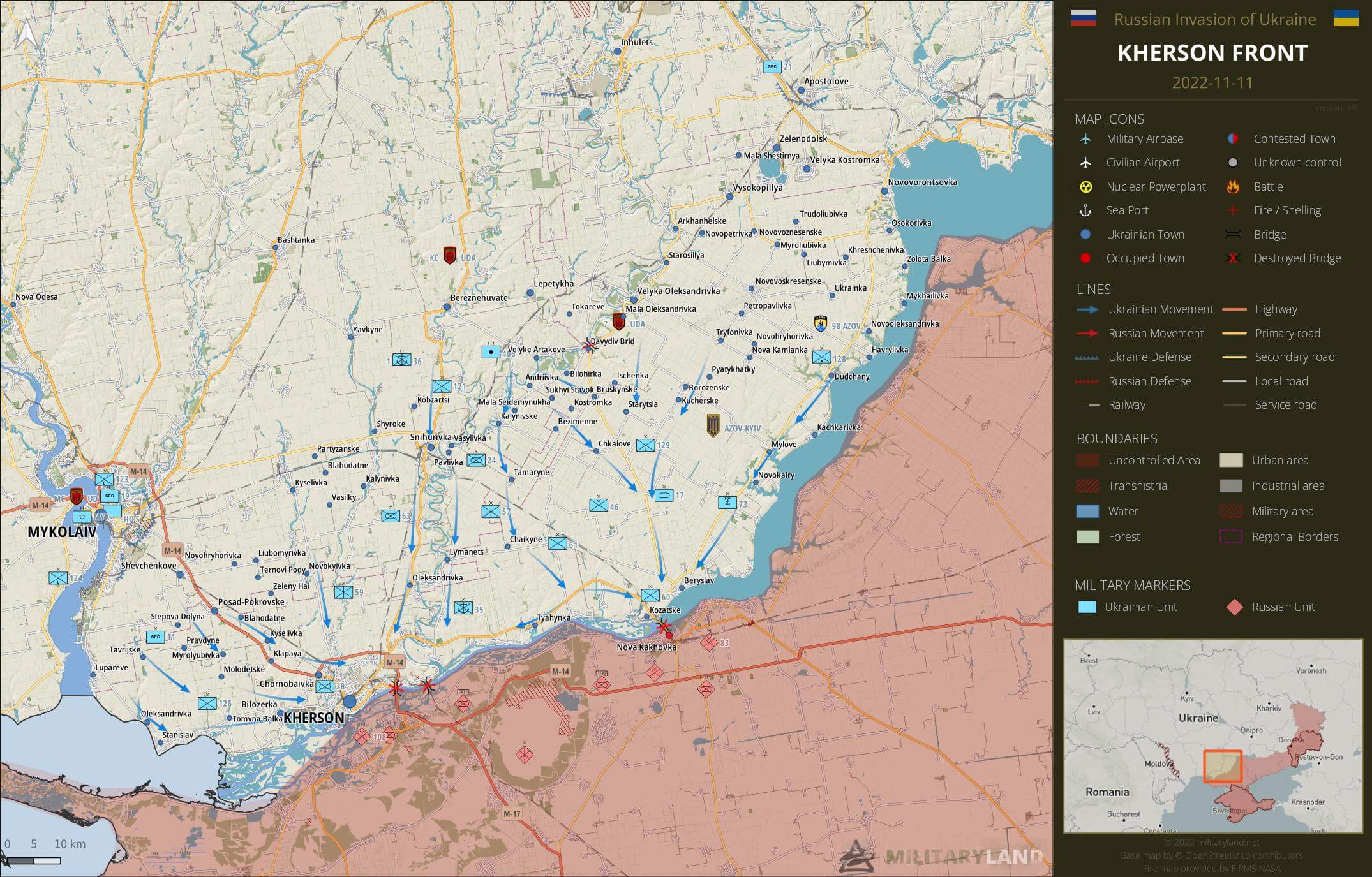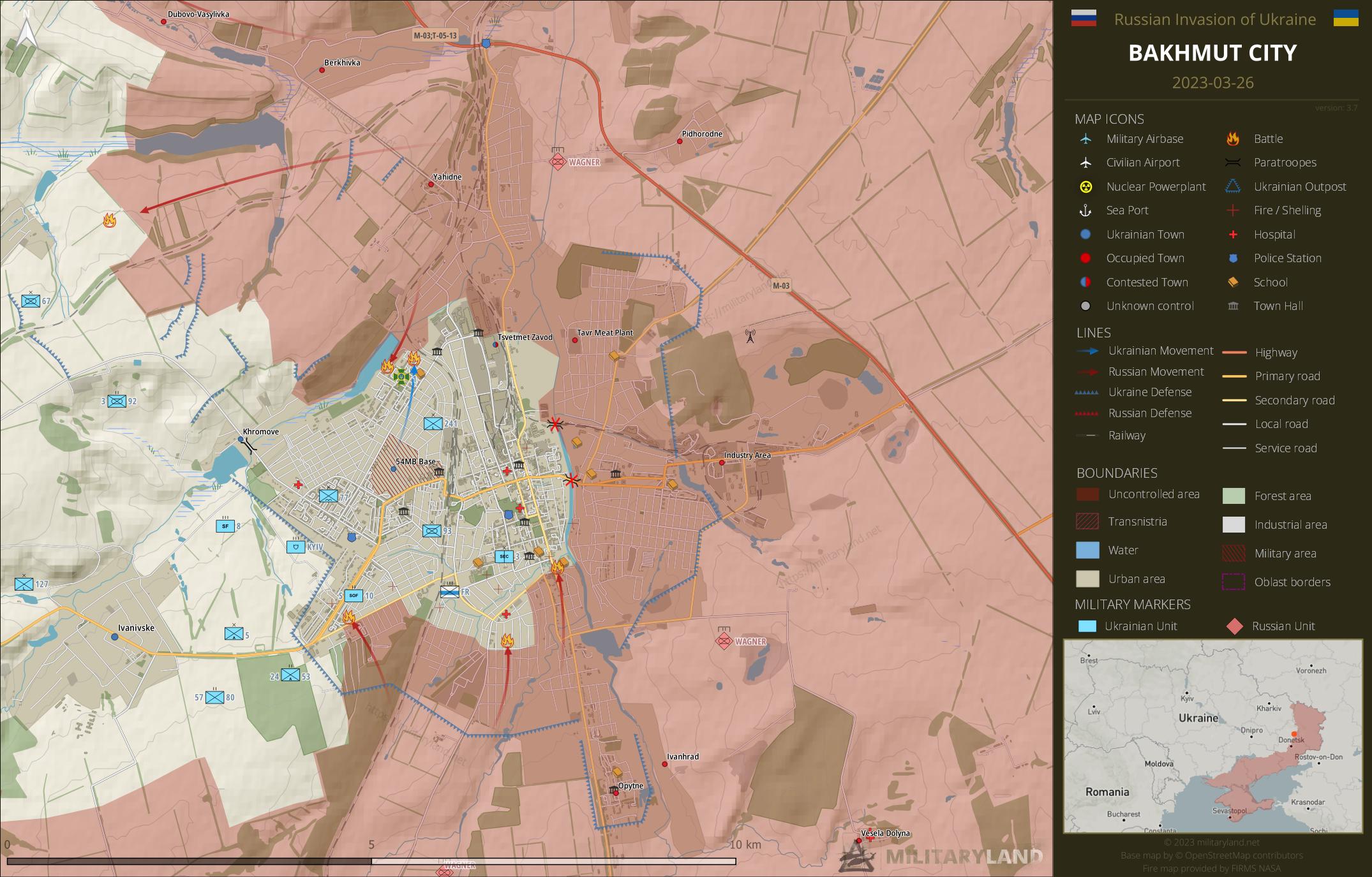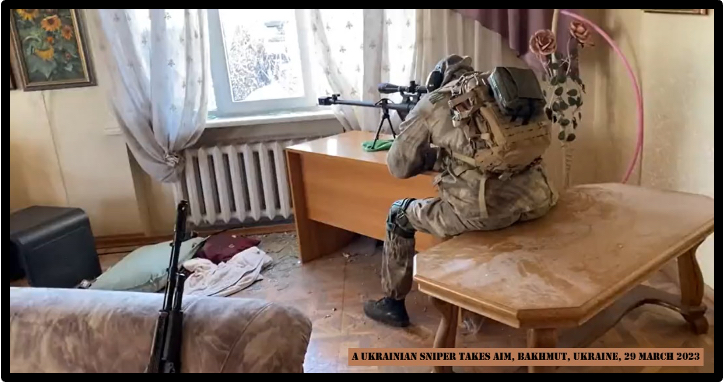Urban Operations in the Russo-Ukraine War: Part Three
Argyll Regimental Foundation Speakers Series Featuring Maj Jayson Geroux
Compiled by LCol (ret) Tom Compton, CD, BA, Director, Argyll Regimental Museum & Archives
Kherson, March–November 2022
This battle was an oddity, to say the least. Putin announced the annexation of Kherson Oblast on 31 September, but the Russian Army failed to stay and fight. The Ukrainian offensive in Kharkiv precipitated panic in Russian formations occupying Ukraine, and they bolted for the left (or south) bank of the Dniepro River. Not a proud moment for the Russian Army, to say the least.
 Image 16. Depicting the rapid collapse of the Kherson front and the advance into the city without any serious fighting. (Source: https://militaryland.net)
Image 16. Depicting the rapid collapse of the Kherson front and the advance into the city without any serious fighting. (Source: https://militaryland.net)
Bakhmut, 1 August 2022 to Present
The battle for Bakhmut began on 1 August 2022. It has been shaped by massive Russian artillery bombardments with ammunition consumption rates similar to the Eastern Front in the Second World War. The financier for Wagner mercenaries, Yevgeny Prigozhin, boasted to Putin that he would take Bakhmut with his Wagner forces alone. Deadlines have come and gone, yet Wagner is still making only incremental gains of 100 to 200 metres per day, or nothing at all. Wagner forces are not professional in any sense; in fact, they are the opposite, in the form of mercenaries, thugs, criminals, and adventurers. The lack of any professional leadership operating in a combined arms context leaves Prigozhin with only the most rudimentary options to fight the battle, such as unsupported human wave attacks. These tactics are extremely costly and harken back to the waste of life by Soviet armies on the Eastern Front, 1942–1943. They require blocking forces behind the untrained Wagner mercenaries to ensure they do not flee the battlefield. There is no operational art or even tactical prowess, just waves of untrained mercenaries hurling themselves onto Ukrainian positions. The casualty rates on both sides have been massive, and each side is careful to not disclose their real losses.
 Image 17. 30 April 2023. Ukrainian forces have been slowly pushed to the west side of the city. (Source: https://militaryland.net)
Image 17. 30 April 2023. Ukrainian forces have been slowly pushed to the west side of the city. (Source: https://militaryland.net)
Zelensky visited Bakhmut, 20 December, 2023, where he met with his troops, presented decorations for bravery, and listened to their comments. While there, he had them sign a Ukraine flag. Zelensky flew to the US the next day and presented the signed flag to the US Congress. These actions were well known to the world, and in so doing Zelensky effectively scored a huge political victory amid a ferocious battle where his troops were slowly giving ground to overwhelming firepower. By 4 March 2023, the Russians had slowly begun to isolate the city with firepower and manoeuvre.
 Image 18. Zelensky in Bakhmut, 20 December 2022, talking to his troops and presenting decorations for bravery. (Source: Ukraine government, published online)
Image 18. Zelensky in Bakhmut, 20 December 2022, talking to his troops and presenting decorations for bravery. (Source: Ukraine government, published online)
 Image 19. Zelensky has soldiers sign the Ukraine flag that was presented the next day to the US Congress. (Source: Ukraine government, published online)
Image 19. Zelensky has soldiers sign the Ukraine flag that was presented the next day to the US Congress. (Source: Ukraine government, published online)
The Wagner attempts at isolating the city continued into May (see Image 17) and eventually culminated through a lack of ammunition and resources, and the exhaustion of their mercenaries. Russian regular army airborne forces were subsequently required to prop up the Wagner flanks. The Ukrainian forces counter-attacked on 12 May, surprising the Russians; they have recaptured a significant amount of territory as of the time of writing. Credible western news sources confirm that Ukraine forces have been pushed to the western edges of Bakhmut. Meanwhile, the Ukrainians have begun their counter-offensive and are attempting to encircle the Russian forces in order to isolate them and dislocate their attacks. This battle is ongoing and may continue for months to come, but it highlights again how the Russians have failed to employ their own doctrine, easily adapt to changing battlefield conditions, and employ professional logistical supply chains. They repeatedly send their own troops and mercenaries in frontal assaults to be slaughtered by creative and flexible defensive tactics.
 Image 20. (From open source video, image used in Maj Geroux’s presentation)
Image 20. (From open source video, image used in Maj Geroux’s presentation)
 Image 21. (From open source video, image used in Maj Geroux’s presentation)
Image 21. (From open source video, image used in Maj Geroux’s presentation)
 Image 22. (From open source video, image used in Maj Geroux’s presentation)
Image 22. (From open source video, image used in Maj Geroux’s presentation)
Events surrounding the Russian assault into Bakhmut continue to evolve, with credible western analysis concluding the culmination of the Russian efforts, exposing their doctrinal weaknesses and execution of their operations:
“The Battle of Bakhmut exposed several key flaws in the Russian planning and conduct of operational maneuver. The Russian military command continued to pursue a relentless assault on Bakhmut after the city lost its original operational significance and failed to adjust its military objectives appropriately. The Kremlin, evidently, chased after any potential victory to generate informational effects and allowed Prigozhin to expend a large amount of Russian ammunition and thousands of prisoner recruits and then more professional forces to maintain a battle of no operational significance in Bakhmut. Prigozhin also continued this battle to gain desired political standing in Russia – likely without the intent to pursue the original goal of conducting a wider encirclement of Donbas. The Kremlin’s fixation with Bakhmut indicates that Russia has not learned lessons from the first phases of the war. The Russian military command continues to overestimate Russian military capabilities and has not mastered time and space relationships in this war at its current level of effectiveness. The Russian military command also continues to pursue ill-informed political objectives at the expense of Russian personnel and resources.” (From https://www.understandingwar.org/backgrounder/kremlin’s-pyrrhic-victory-bakhmut-retrospective-battle-bakhmut-may-25-2023)
More recent operations suggest the Russians have learned to use their defence doctrine as it was intended, resulting in very fierce but slow advances by the Ukrainians.